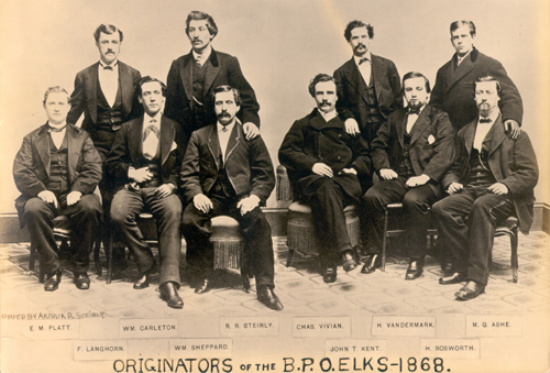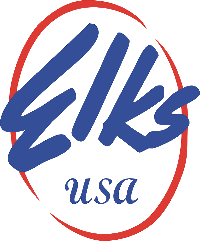The
Story, always interesting, is the story of the expansion of a dream
of brotherhood into the greatest of American Fraternities.
On
Friday, November 15th , 1867, Charles A. Vivian, an English comic singer,
landed in New York via an English trading vessel from South Hampton.
On the night of his arrival he dropped into the Star Hotel, a Free and
Easy kept by John Ireland on Lispenard street near Broadway. Richard
R. Steirly, also of English birth, was a piano player at the Star Hotel.
Vivian struck up an acquaintance with him and volunteered to sing a
few songs. He made such an impression on John Ireland that the latter
sent for his friend, Robert Butler, manager of the American Theater
on Broadway. Vivian sang for Butler, making such a hit that he was engaged
for a three weeks run at the American. When closing time came at the
Star Hotel, Steirly took Vivian around to his boarding house at 188
Elm Street, kept by Mrs. Giesman, There he found a collection of congenial
spirits, among them William Bowron, who also knew Vivian in his native
land, *** The streets in that section of New York have been re-plotted
and their names changed so that the plot known as 188 Elm Street can
now be found on LaFayette Street in the block between Broome and spring
Streets, In 1939 the Council of the City of New York passed the following
resolution: Be it resolved... that the two blocks remaining on Elm Street
be known as Elk Street to pay tribute to the famous Order of Elks which
was founded on that Street in the year 1867.
On November 23rd , 1867, Dick Steirly went to the American Theater to
take notes for the purpose of orchestrating some of Vivian's songs.
After the matinee, Vivian took Steirly over to Sandy Spencer's place
at Broadway and Fulton Street, There they met Hughley Dougherty, Cool
Burgess and Henry Vandemark. The latter suggested that the party shake
dice for the refreshments. Vivian replied that he never handled the
cubes, but would show them a new game. Calling for three corks he gave
one each to Steirly and Vandemark, keeping the other for himself, He
asked Cool Burgess to be the judge and Dougherty to count to three.
They rehearsed the trick of each dropping his cork on the bar and picking
it up as rapidly as possible, several times, the idea conveyed to initiated
being that the last man to lift his cork was to buy. Vivian then gave
the word of command, Dougherty counted, He and Steirly passed their
hands over their corks while Vandemark, eager to lift his cork from
the bar, was both first and last to pick it up, and consequently was
stuck for the round. This was the first introduction of a delectable
form of amusement which became popular.

BIRTH
OF THE JOLLY CORKS
At
about this time the Excise Law was being strictly enforced and Sunday
in New York City was a very dry day. Devotees of the cork trick formed
the habit of congregating at Mrs. Giesman's on this day to hold social
conventions under the inspiring influences of a stock of beer laid in
the night before. This little coterie styled itself the Corks, with
Vivian as the Imperial Cork.
The revels of the Jolly crew meeting at Mrs. Giesman's became disturbing
to the other boarders and she finally required them to forego their
Sunday gatherings in her house. Quarters were found at 17 Delancy Street,
over a saloon kept by Paul Sommers, where the meetings were continued,
The object of the Corks at this time was entirely convivial, it's membership
was composed of professional and semi-professional entertainers with
a sprinkling of legitimate actors. Among the latter were Thomas Riggs,
George McDonald, William Sheppard and George Thompson, a theatrical
agent. When the cork trick was tried on McDonald it amused him so that
he called the coterie the JOLLY CORKS, and as such it has gone down
upon the pages of history, In the latter part of December just before
the holidays, they were returning from a funeral of a friend, Ted Quinn,
when McDonald suggested that the Jolly Corks become a protective and
benevolent society. At the meeting held on the 2nd of February, 1868,
presided over by Charles A. Vivian, George McDonald offered a motion
to organize the Jolly Corks as a lodge along benevolent and fraternal
lines and providing a committee be appointed to formulate rules and
regulations for it's government, prepare a suitable ritual, and select
a new name. Vivian having in mind an English organization, The Royal
Antediluvian Order of Buffalos, but the majority were desirous of bestowing
a distinctively American title upon the new organization. A committee
visited Cooper Institute Library, where the Brothers found the ELK described
in a work on Natural History as an animal fleet of foot, timorous of
doing wrong, but ever ready to combat in defense of self or of the female
of the species. This description appealed to the committee as containing
admirable qualities for emulation by members of a benevolent fraternity
and the title ELK was incorporated in its report.
BIRTH
OF THE ORDER OF ELKS
On
February 16, 1868, the committee reported, recommending that the Jolly
Corks be merged into the Benevolent and Protective Order of Elks and
the recommendation was adopted by a vote of eight (8) to seven (7).
Listed below are those who voted for what name.
For BUFFALO: Charles A. Vivian; Richard Steirly; M.G. Ash; Henry Vandermark;
Harry Bosworth; Frank Langhorne; E. W. Platt.
For
ELK: George McDonald; George Thompson; Thomas Riggs; William Carleton;
William Sheppard; George Guy; Hugh Dougherty; William Bowron.
The
Death of Charles A. Vivian
Before passing from this branch of the resume
of Elks History, it will not be inappropriate to mention the death of
Brother Vivian. With the beginnings of the B.P.O.E. a breech was opened
between two factions within the ranks, which rapidly developed into
a feud. On one hand were the legitimate actors, endeavoring to invest
the new organization with principals and ideas in keeping with a benevolent
and fraternal institution, while on the other were the semi-professional
entertainers more in sympathy with the original purposes of the convivial
Jolly Corks.
Charles Vivian was the leader of the latter faction, and when he appeared
for the second degree on 14 June 1886, the professionals who were in
command ordered a ballot and he was rejected. At the same time a number
of Vivian's friends were barred from the meeting and afterwards declared
expelled. This incident ended Vivians connection with the B.P.O. Elks.
He died in Leadville, Colorado, March 20, 1880, twelve years later,
of Pneumonia. On April 28, 1889, the remains of Charles Vivian were
exhumed and taken to Boston, under the auspices of Boston Lodge # 10,
where they rest in Mt. Hope Cemetery. As far as can be learned from
personal friends, Vivian never claimed to have been an ELK. He did claim
to have been one of the organizers of the Elks, which he was, but ne
never took the degrees of the Order, and severed all connections with
it a few months after it was born.
(
This was copied from a publication from Bath Lodge # 1547, N.Y. by Exalted
Ruler William Kastner, December 1986)





